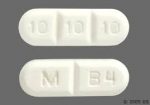Buprenorphine hydrochloride used for the treatment of opioid dependence, relieving acute pain, and also as an anesthetic in oncology.
The drug is prescribed only in the special centers and clinics for the treatment of the patients under medical supervision. You should take the pill under the tongue and hold in your mouth until its complete dissolving. Buprenorphine should be taken in the case of objective signs of abstinence or at least 6 hours after the last intake of opioids.
The recommended initial dose for the treatment of opioid dependence is 4-8 mg, and further it is titrated according to the patient’s condition to 2-4 mg a day. The interval between the drug intakes is 6-8 hours. The maximal daily dose is 32 mg. The duration of treatment depends on the patient’s condition.
Side effects
The onset of side effects depends on the patient’s tolerance. In the addicted people, this rate is significantly higher than in the patients who don’t take drugs.
Possible side effects
[tie_list type=”checklist”]
- Mental disorders: hallucinations.
- Nervous system: insomnia, headache, fainting, dizziness.
- Vascular system: orthostatic hypotension.
- Respiratory, thoracic and mediastinal disorders: failure of the respiratory center.
- GI: constipation, sickness, vomiting.
- General disorders: weakness, drowsiness, excessive sweating.
- Immune system: hypersensitivity reaction (such as rash, urticaria, itching, bronchospasm), Quincke’s disease (angioedema), anaphylactic shock.
- Hepatobiliary system (in very few cases, if used correctly): increased level of liver transaminases and jaundice, usually with the favorable clinical course.
[/tie_list]
In patients with the pronounced physical (somatic) drug addiction, the first sublingual administration of buprenorphine hydrochloride can cause paradoxical reaction the development of withdrawal syndrome, similar to naloxone.
Contraindications
[tie_list type=”checklist”]
- Hypersensitivity to buprenorphine or any other drug ingredient;
- Acute respiratory failure
- Acute liver and renal failure
- Acute alcohol intoxication
- Alcohol withdrawal
- Acute heart failure
- Craniocerebral injuries
- Pregnancy and lactation period
- The age under 12
[/tie_list]
Simultaneous use of the following psychotropic drugs and substances is inadvisable
Alcohol. It increases the sedative effect of buprenorphine. Decreased attention raises the risk in driving and working with mechanisms. It is necessary to avoid alcohol consumption and use of drugs, containing alcohol.
Benzodiazepines. Simultaneous use with the benzodiazepines entails the risk of death from respiratory failure, associated with CNS dysfunctions.
Other CNS depressants. Simultaneous use of other opiate derivatives (analgesics, antitussives), some antidepressants, antihistamines (H1 blockers), barbiturates, tranquilizers, clonidine with buprenorphine cause the increase of CNS depression.
MAO inhibitors. The simultaneous use of buprenorphine can increase the action of opioids.





